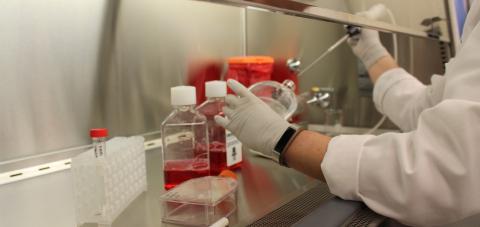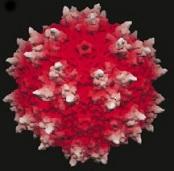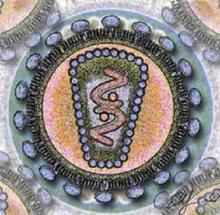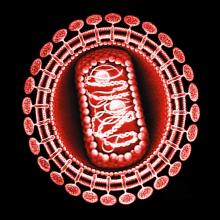Some viruses are quite fragile because they have lipid membranes. Therefore, it is important to know how to store and use them. The virus core can generate high-quality viruses but if they are not stored and used properly they may be inactivated.
The links below describe proper storage and use of AAVs, lentiviruses, and retroviruses:
Care and Handling of Adeno-Associated Viruses (AAV)
It is useful to think of AAV as a very large protein (MW= ~5,200,000). As such, it is relatively stable but should be treated with at least as much care as other proteins. It is resistant to most proteases and a variety of chemical treatments that would inactivate many viruses. However, because it is so large, it has a large surface area and is more likely to stick to hydrophobic surfaces and aggregate than smaller proteins.
DON'T:
- Don’t expose to environmental extremes (pH, chelating agents like EDTA, temperature, organic solvents, protein denaturants, strong detergents, etc.) that denature proteins.
- Don’t introduce air into the sample by vortexing, blowing bubbles and similar operations (which results in protein denaturation).
- Don’t dry (which results in protein denaturation).
- Don’t freeze and thaw multiple times. AAV is more stable than many viruses or proteins and can be frozen and thawed several times with minimal loss of activity, but it is best to avoid.
- Don’t expose to “regular” plastics (especially polystyrene or similar very hydrophobic plastics) for prolonged periods in a liquid phase. Most AAVs are very sticky and losses can occur if they are exposed to regular plastics (e.g., tubes, cell culture plates, pipette tips) if they are not frozen. It is best to store thawed AAV in siliconized or low protein binding tubes and pipette it with similar pipette tips. Pluronic F-68 used at 0.01%-0.1% in the formulation buffer will minimize sticking if regular plastics are used.
- Don’t dilute into low salt. Some AAVs (e.g., AAV-2) aggregate in low salt and if the aggregates are large they will be non-infectious.
DO:
- Do aliquot and freeze at -80C for long-term storage if the virus is not used within 1-2 weeks.
NOTE:
- AAV appears to retain infectious activity for >10 years when stored at -80C.
Care and Handling of VSV-G Pseudotyped Lentiviruses
It can be useful to think of lentiviruses as small cells. They have a membrane and a small amount of cytoplasm. The capsid, which contains the genome, is somewhat like a nucleus. As such, they are very unstable and should be treated gently as a cell would be.
DON'T:
- Don’t expose to environmental extremes (such as pH, temperature, organic solvents, protein denaturants, strong detergents, or cation chelators such as EDTA). ALL liquids the virus is in (dilution buffers, cell culture media, etc.) should be pH= ~7.2. Add 10 mm HEPES if in doubt to buffer the pH.
- In particular, the VSV-G protein, which is on the surface of the virus and is required for infection, is extremely pH sensitive. It loses about 10-fold in infectious activity for each 0.3 unit drop in pH below ~pH 7.0. Although this effect is reversible to some degree, the reversibility is time dependent. Because of this pH sensitivity ALL liquids the virus is in (dilution buffers , cell culture media, etc.) should be pH= ~7.2. Add 10 mM HEPES if in doubt to buffer the pH.
- Don’t expose to any condition that disrupts membranes (such as temperature, organic solvents, and strong detergents). This will result in near complete inactivation because an intact viral membrane is required for viral infection.
- Don’t introduce air into the virus by vortexing, blowing bubbles, and similar operations, which result in protein denaturation. Denatured VSV-G, which is required for infection, is inactive.
- Don’t dry. Drying will also result in membrane disruption and near complete inactivation of the virus.
- Don’t freeze and thaw multiple times. The titer may drop 2-3 fold (or more) with each freeze-thaw cycle. Therefore, it is best to avoid.
- Don’t expose to hydrophobic plastics (especially polystyrene) for prolonged periods. Because lentiviruses are surrounded by a mostly hydrophobic membrane they are very sticky and losses can occur if they are exposed to hydrophobic plastics while not frozen. It is best to store thawed lentiviruses in siliconized or low protein binding tubes and pipette it with similar pipette tips.
- Don’t filter. Filtering can reduce titer because viruses can stick to the filter. If filtering is necessary it is essential to use filters with 0.45 μm (or larger) pores. Since the diameter of a lentivirus is about 0.15-0.2 μm, if a filter with 0.2 μm (or smaller) pores is used, substantial loss of infectious titer can occur.
DO:
- Do aliquot and freeze at -80C for long-term storage if the virus is not used within ~1 week. Besides being intrinsically unstable it is possible for microorganisms to grow in residual cell culture media that is in the virus. Freezing helps prevent this.
- Thaw on ice just before use.
- Use virus within ~6 months of storage at -80C unless the titer is much higher than needed. Even when stored at -80C, lentiviruses will lose ~10x in titer every 6-12 months.
Care and Handling of Retroviruses
It can be useful to think of retroviruses as small cells. They have a membrane, a small amount of cytoplasm and the capsid containing the genome is somewhat like a nucleus. As such, they are very unstable and should be treated gently as a cell would be.
DON'T:
- Don’t expose to environmental extremes (such as pH, temperature, organic solvents, protein denaturants, strong detergents, or cation chelators such as EDTA). ALL liquids the virus is in (dilution buffers , cell culture media, etc.) should be pH= ~7.2. Add 10 mM HEPES if in doubt to buffer the pH.
- In particular, the VSV-G protein, which is on the surface of the virus and is required for infection, is extremely pH sensitive. It loses about 10-fold in infectious activity for each 0.3 unit drop in pH below ~pH 7.0. Although this effect is reversible to some degree, the reversibility is time dependent. Because of this pH sensitivity ALL liquids the virus is in (dilution buffers , cell culture media, etc.) should be pH= ~7.2. Add 10 mM HEPES if in doubt to buffer the pH.
- Don’t expose to any condition that disrupts membranes (such as temperature, organic solvents, strong detergents). This will result in near complete inactivation because an intact viral membrane is required for viral infection.
- Don’t introduce air into the virus by vortexing, blowing bubbles, and similar operations, which result in protein denaturation. Denatured envelope proteins, which are required for infection, are inactive.
- Don’t dry. Drying will also result in membrane disruption and near complete inactivation of the virus.
- Don’t freeze and thaw multiple times. The titer may drop 2-3 fold (or more) with each freeze-thaw cycle. Therefore it is best to avoid.
- Don’t expose to hydrophobic plastics (especially polystyrene) for prolonged periods. Because retroviruses are surrounded by a mostly hydrophobic membrane they are very sticky and losses can occur if they are exposed to hydrophobic plastics while not frozen. It is best to store thawed retroviruses in siliconized or low protein binding tubes and pipette it with similar pipette tips.
- Don’t filter. Filtering can reduce titer because viruses can stick to the filter. If filtering is necessary it is essential to use filters with 0.45 45 μm (or larger) pores. Since the diameter of a retroviruses is about 0.15-0.2 μm, if a filter with 0.2 μm (or smaller) pores is used, substantial loss of infectious titer can occur.
DO:
- Do aliquot and freeze at -80C for long-term storage if the virus is not used within ~1 week. Besides being intrinsically unstable, it is possible for microorganisms to grow in residual cell culture media that is in the virus. Freezing helps prevent this.
- Thaw on ice just before use.
- Use virus within ~6 months of storage at -80C unless the titer is much higher than needed. Even when stored at -80C, retroviruses will lose ~10x in titer every 6-12 months.



